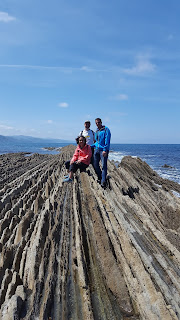In October of 2017, we wrote about our adventure hiking the Flysch Route from Deba to Zumaia. Last Sunday (May 12), we returned to Zumaia for a boat tour of the flysch, which allowed us to learn a lot more about what flysch is and to get some fantastic views from the sea:
As you can see, it was a beautiful day to be on the water. Here is Adam enjoying the scenery:
After the one-hour boat tour, we took some time to enjoy the flysch from the shore as well:
Two further GoT fun facts from the Basque region: (1) Zumaia is actually not close to San Juan de Gaztelugatxe where Dragonstone is set (ah, the magic of film), and (2) Daenerys's throne is designed to look like flysch. So, if you want to come see the places that inspired part of the show, we will be happy to show you around.
So, what did we learn about flysch? (Anyone who doesn't care about science stuff can safely skip this paragraph and the next.) We learned that flysch is layers of sediment that was turned on its side when the Iberian Peninsula collided with the rest of the European continent sometime between 20 and 80 million years ago (this collision also formed the Pyrenees Mountains). Before that, the Basque region was under water, and the layers of sediment were at the bottom of the ocean. However, the collision and formation of the flysch allows scientists to read the geological record like a book. Now, instead of layers of sediment getting older from top to bottom, they get older from east to west, allowing for easier research about the history of the planet.
For me, the most interesting thing is how the flysch supports the theory that a meteor striking earth led to worldwide climate change and the extinction of the dinosaurs (along with 75% of other species 66 million years ago). You can actually see in the flysch the line that marks the K/Pg (Cretaceous/Paleogene) boundary. This layer contains a large amount of iridium, an element that is very rare on earth, but very common in meteorites. Pretty cool.
Overall, it was a very fun and educational day, capped off by Shana making a new friend. This is Kaia, and she is only two months old:
Hasta pronto,
Jeff and Shana











No comments:
Post a Comment